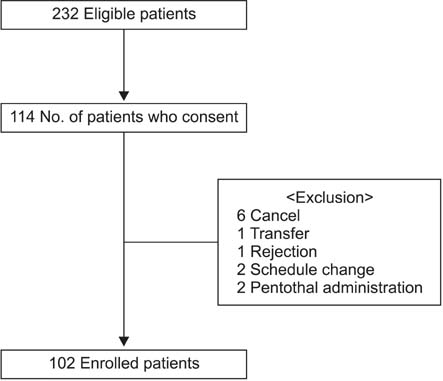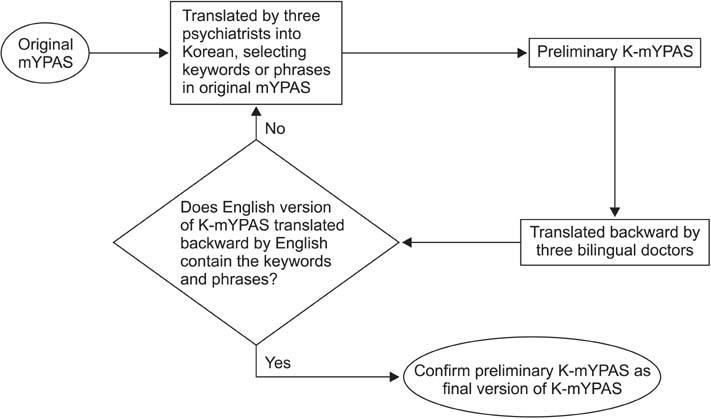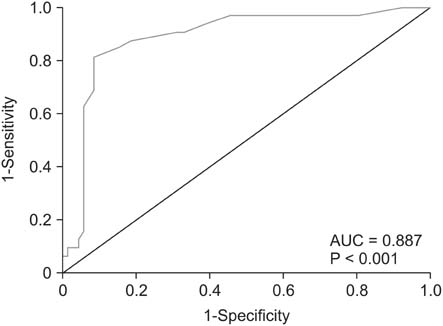Ann Surg Treat Res.
2016 Jan;90(1):43-48. 10.4174/astr.2016.90.1.43.
Reliability and validity of Korean version of modified: Yale preoperative anxiety scale
- Affiliations
-
- 1Department of Surgery, Seoul National University Bundang Hospital, Seongnam, Korea.
- 2Department of Child and Adolescent Psychiatrics, Seoul National University Hospital, Seoul, Korea. beauscent@naver.com
- 3Department of Ophthalmology, Seoul National University Bundang Hospital, Seongnam, Korea.
- 4Department of Anesthesiology, Seoul National University Bundang Hospital, Seongnam, Korea.
- 5Department of Pediatric Orthopedic Surgery, Seoul National University Bundang Hospital, Seongnam, Korea.
- 6Department of Otorhinolaryngology-Head & Neck Surgery, Seoul National University Bundang Hospital, Seongnam, Korea.
- 7Child and Adolescent, Seoul Top Ma-Eum Clinic, Seoul, Korea.
- 8Department of Nursing, Seoul National University Bundang Hospital, Seongnam, Korea.
- 9Department of Surgery, Kangwon National University School of Medicine, Chuncheon, Korea.
- KMID: 2149931
- DOI: http://doi.org/10.4174/astr.2016.90.1.43
Abstract
- PURPOSE
The modified Yale Preoperative Anxiety Scale (mYPAS) was developed for evaluating the level of preoperative anxiety in children. The purpose of this study was to develop a Korean version of the mYPAS (K-mYPAS) and to establish its validity and reliability based on the Korean preoperative pediatric patients.
METHODS
K-mYPAS was made through stringent back-translation procedure. Total enrolled 102 patients answered questionnaires of Korean version of State-Trait Anxiety Inventory for Children (K-STAIC), and were videotaped for 2 to 5 minutes before induction of anesthesia. Three observers of experienced psychiatrist, surgeon, and nurse analyzed videotape with K-mYPAS comparing to K-STAIC. The inter- and intraobservers reliability, concurrent and construct validity, sensitivity, specificity, and predictive value were analyzed.
RESULTS
The value of Cronbach alpha for interobservers reliability was 0.939 and intraobserver reliability was statistically significant (P < 0.001). Concurrent and construct validity were also statistically significant (P < 0.001 and P < 0.001, respectively). Sensitivity, specificity, positive predictive value, negative predictive value, and accuracy were 81.3%, 91.4%, 81.3%, 91.4%, and 88.2%, respectively.
CONCLUSION
The K-mYPAS had good psychometric properties and can be used as a reliable and valid instrument for the assessment of preoperative anxiety in children.
MeSH Terms
Figure
Reference
-
1. Vernon DT, Schulman JL, Foley JM. Changes in children's behavior after hospitalization. Some dimensions of response and their correlates. Am J Dis Child. 1966; 111:581–593.2. Kain ZN, Mayes LC, O'Connor TZ, Cicchetti DV. Preoperative anxiety in children. Predictors and outcomes. Arch Pediatr Adolesc Med. 1996; 150:1238–1245.3. Spielberger CD. Manual for the State-Trait Anxiety Inventory for children. Palo Alto (CA): Consulting Psychologists Press;1973.4. Speilberger CD. Manual for the State-Trait Anxiety Inventory (STAI: Form Y). Palo Alto (CA): Consulting Psychologists Press;1983.5. Kain ZN, Mayes LC, Cicchetti DV, Bagnall AL, Finley JD, Hofstadter MB. The Yale Preoperative Anxiety Scale: how does it compare with a "gold standard"? Anesth Analg. 1997; 85:783–788.6. Wollin SR, Plummer JL, Owen H, Hawkins RM, Materazzo F. Predictors of preoperative anxiety in children. Anaesth Intensive Care. 2003; 31:69–74.7. Cicchetti DV, Volkmar F, Sparrow SS, Cohen D, Fermanian J, Rourke BP. Assessing the reliability of clinical scales when the data have both nominal and ordinal features: proposed guidelines for neuropsychological assessments. J Clin Exp Neuropsychol. 1992; 14:673–686.8. Cho SC, Choi JS. Development of the Korean form of the State-trait Anxiety Inventory for Children. Seoul J Psychia. 1989; 14:150–157.9. Proczkowska-Bjorklund M, Gimbler Berglund I, Ericsson E. Reliability and validity of the Swedish version of the modified Yale Preoperative Anxiety Scale. Acta Anaesthesiol Scand. 2012; 56:491–497.10. Wilmore DW, Kehlet H. Management of patients in fast track surgery. BMJ. 2001; 322:473–476.11. Fearon KC, Ljungqvist O, Von Meyenfeldt M, Revhaug A, Dejong CH, Lassen K, et al. Enhanced recovery after surgery: a consensus review of clinical care for patients undergoing colonic resection. Clin Nutr. 2005; 24:466–477.12. Soreide E, Eriksson LI, Hirlekar G, Eriksson H, Henneberg SW, Sandin R, et al. Pre-operative fasting guidelines: an update. Acta Anaesthesiol Scand. 2005; 49:1041–1047.13. Hausel J, Nygren J, Lagerkranser M, Hellstrom PM, Hammarqvist F, Almstrom C, et al. A carbohydrate-rich drink reduces preoperative discomfort in elective surgery patients. Anesth Analg. 2001; 93:1344–1350.14. Bufalini A. Role of interactive music in oncological pediatric patients undergoing painful procedures. Minerva Pediatr. 2009; 61:379–389.15. Mifflin KA, Hackmann T, Chorney JM. Streamed video clips to reduce anxiety in children during inhaled induction of anesthesia. Anesth Analg. 2012; 115:1162–1167.
- Full Text Links
- Actions
-
Cited
- CITED
-
- Close
- Share
- Similar articles
-
- Korean Self-Report Version of the Yale-Brown Obsessive-Compulsive Scale: Factor Structure, Reliability, and Validity
- Validity and Reliability of the Korean Version of the Index of Dental Anxiety and Fear
- Appropriateness of the anxiety subscale of the Hospital Anxiety and Depression Scale for Koreans to measure preoperative anxiety and the effect of preoperative anxiety on postoperative quality of recovery
- Reliability and Validity of the Korean Version of the Modified Adult Attachment Scale for the Use of Medically Ill Patients
- Reliability and Validity of the Korean Version of the Kenny Music Performance Anxiety Inventory




